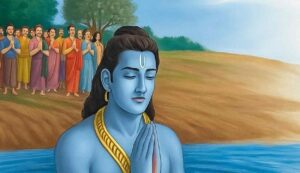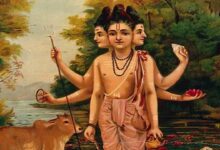Ramayana Story: Why did Shri Ram take Jal Samadhi at the last moment, know about the story related to it
Ramayana Story: Through his life, Lord Shri Ram, also known as Maryada Purushottam, instilled in the populace the values of faith, responsibility, and love. Throughout his life, he has imparted knowledge to others. The strange event known as “Jal Samadhi” also marked the end of his life. The epic Ramayana recounts the last events of Shri Ram’s life. Tell us why Shri Ram decided to do Jal Samadhi at the last minute.

The Jal Samadhi of Shri Ram
According to the Uttarakand of the Valmiki Ramayana, after finishing his work on Avatar and Rajdharma, Shri Ram entered Jal Samadhi. This occurrence occurred during his last years. According to Dharma, he had controlled Ayodhya for many years before this. In addition to being a representation of a king throughout his reign, he was also a model husband, brother, son, and father. His passing also served as a source of encouragement for the populace.
The dilemma of whether Shri Ram should leave his physical body and return to his original form—that is, Lord Vishnu—arose after his incarnation job was over, according to legend. After Mother Sita had already become one with the soil, Shri Ram felt alone and detached. Furthermore, Laxman, the brother of Shri Ram, had already sacrificed his body. In order to conclude his incarnation job, Shri Ram made the decision to accept Jal Samadhi.
The cause of Jal Samadhi
In addition to the tale of Shri Ram’s Jal Samadhi, many people wonder why he accepted it. Numerous justifications are offered in mythology for Shri Ram’s choice.
The Avtaar project was finished
Mythology states that Shri Ram was Lord Vishnu’s seventh incarnation, who slew Ravana and other demons to bring the light of religion to the world. After completing his mission, he made the decision to return to Vaikunth, his native location, in the avatar of Lord Vishnu. Jal Samadhi was a serene and magical manner to go from his physical body in such a circumstance.
Mata Sita’s separation
The Earth’s daughter was Mata Sita. After being insulted and having her innocence questioned by society, she made the decision to become one with the soil. As a result of his wife Sita ji’s separation, Shri Ram began to feel lonely at Ayodhya. According to some legends, Shri Ram’s thoughts drifted away from the outside world when Sita departed, and he made the decision to commit himself via Jal Samadhi.
Lakshman’s death
In addition to being Shri Ram’s brother, Laxman was also a devoted follower of the deity. Following a previous mythical episode, Laxman had also undergone Jal Samadhi in the Saryu River. Mythology states that Yamraj once came to speak with Shri Ram in private and that he made it clear that anybody who interrupted them would face the death sentence. Lakshman protected the entrance, but when the sage Durvasa arrived, Lakshman got in the way of their talk. Shri Ram chose to punish Lakshman in accordance with Dharma, but instead of executing him, he let him take Jal Samadhi himself. Lakshman’s departure left Shri Ram’s life feeling even more unfinished.
Dignity and dharma also became the cause
Being Maryada Purushottam, Shri Ram had devoted his whole life to religion. For him, taking Jal Samadhi was a respectable and biblical approach to convey to his followers that life should also end in peace and Dharma. Simultaneously, other traditions tell how Kaal, or time itself, appeared to Shri Ram as a saint and told him that his incarnate existence was coming to an end. After saying goodbye to his family and followers, Shri Ram obeyed Kaal’s command and took Jal Samadhi.

